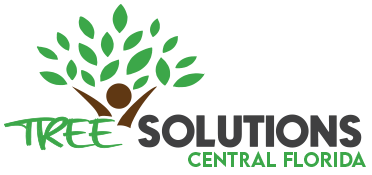1. Tree Care Terms (Florida-Friendly Explanations) #
- Arborist – A tree care professional trained in tree biology, pruning, removal, and safety. Certified arborists in Florida are experts in hurricane prep and storm damage recovery.
- Canopy – The leafy top of a tree. Provides shade, helps cool yards, and supports wildlife.
- Crown Raising – Removing lower branches for clearance near driveways, sidewalks, or roofs.
- Crown Reduction – Trimming back the canopy’s height/spread to reduce storm risk.
- Thinning – Selectively removing branches for better airflow and reduced hurricane wind resistance.
- Topping (Not Recommended) – Cutting off the top of a tree; weakens structure and is discouraged in Florida’s storm-prone climate.
- Stump Grinding – Grinding down a tree stump after removal to restore a flat yard surface.
- Drip Line – The outer edge of the canopy, where water naturally falls—ideal for watering and fertilizing.
- Mulching – Adding organic material at the tree base to conserve water and protect roots.
- Hazard Tree – A tree that poses a falling risk due to rot, damage, or instability. Especially important to monitor before hurricane season.
- Emergency Tree Service – Urgent removal of storm-damaged or fallen trees threatening homes or powerlines.
- Tree Lifecycle Planning – A proactive schedule of care, pruning, and replacement planning to keep landscapes safe and attractive over decades.
- Permit – Many Florida counties (Volusia, Flagler, St. Johns, etc.) require permits to remove large or protected trees.
2. Common Florida Trees (Identification & Care) #
🌳 Live Oak (Quercus virginiana) #
- ID: Wide, sprawling canopy; evergreen leaves; iconic Southern oak.
- Care: Strong and hurricane-resistant, but needs periodic thinning to reduce wind load. Watch for Spanish moss and mistletoe buildup.
🌴 Sabal Palm (Cabbage Palm, Florida’s State Tree) #
- ID: Fan-shaped fronds, smooth gray trunk, often found in coastal areas.
- Care: Extremely hardy; remove dead fronds to reduce fire and pest risk.
🌲 Bald Cypress (Taxodium distichum) #
- ID: Feathery leaves, flared base (“knees”), thrives in swamps and near water.
- Care: Low maintenance; needs space for knees if planted in landscapes.
🌸 Southern Magnolia (Magnolia grandiflora) #
- ID: Glossy green leaves, large white fragrant flowers.
- Care: Benefits from mulching and pruning lower limbs to maintain form.
🍊 Citrus Trees (Orange, Lemon, Grapefruit) #
- ID: Shiny leaves, fragrant blossoms, edible fruit.
- Care: Susceptible to citrus greening in Florida; requires attentive pest management and fertilization.
🌲 Slash Pine (Pinus elliottii) #
- ID: Tall, straight trunk; long needles in clusters of two or three.
- Care: Vulnerable to lightning strikes and storm breakage; pruning helps reduce hazards.
🌳 Red Maple (Acer rubrum) #
- ID: Bright red fall color; grows in wetter soils.
- Care: Fast-growing; prune carefully to prevent weak limb structure.
🌴 Washingtonia Palm (Washingtonia robusta) #
- ID: Tall “skyscraper” palm common in Central Florida landscapes.
- Care: Requires regular dead frond removal; can be vulnerable to hurricanes due to height.




